Wednesday, September 30, 2015
Round table looks to help asbestos cancer victims
Titan helps unpuzzle decades-old plutonium perplexities
Former Northland radio & TV broadcaster dies of brain cancer
Clovis Oncology Announces U.S. and E.U. Regulatory Milestones for Rociletinib in the Treatment of Advanced EGFR-Mutant T790M+ Non-Small Cell Lung Cancer
11 Ways to Boost Your Energy With Food
Gleason 6 Prostate “Cancer”the prostate cancer awareness charade
The Bon-Ton Stores, Inc. Kicks Off National Breast Cancer...
American Parenting And The Culture Of Worry
What weighs on the minds of American parents today? For many of them, it’s a fear that their young children are at risk of falling behind. “I try and read up on … what a 2-month-old should be doing, what a 3-month-old should be doing,” says a mom of an infant daughter, “so I can make sure that I do some activities that are helping her develop those skills and things that she needs to do.”
The mother is reading up on what her 2-month-old “should be doing.” She wants to make sure her newborn is on the right track. If you’re a parent living in the United States right now, this concern may sound all too familiar.
But taking a wider view on early childhood development reveals many, and differing, perspectives on what success looks like when it comes to how our kids grow from newborns to toddlers to kindergarteners and beyond.
Dr. Sara Harkness recorded that story of the new mom and her daughter, along with numerous others, as part of her ongoing anthropological research. A professor of human development, pediatrics and public health at the University of Connecticut, Harkness has been examining parents’ cultural beliefs and childcare practices all over the world, from families in the United States to those in rural communities of Kenya and indigenous areas of Guatemala and Peru, for decades.
The modern American parent stands out for placing such a high priority on cognitive processing and stimulation of cognitive development. Moms and dads ask themselves, are my kids losing ground on their peers -- maybe even while still in utero? It’s FOMO (fear of missing out) for parents.
Where does this fear come from? Where doesn’t it come from? Books. Articles. Casual conversations. Our friends’ Facebook feeds. Geography champs on talk shows. And does anyone remember this oft-repeated message? “The natural window of opportunity to learn written language is at the same time children learn to speak."
That was what the announcer in the “Your Baby Can Read” infomercials repeated again and again, on channel after channel. Except it wasn’t true. Which is why the Federal Trade Commission sued the company behind the claims in 2013. The company’s massive ad campaign was deceptive, according the FTC; and the company eventually settled -- but for many parents, the announcer and the commercial can’t be unheard.
Even in our schools, mothers and fathers are made to feel anxious. “Parents are now told they should worry about how many words their child hears by the age of 3, and whether their child has the necessary skills to be ready for preschool -- essential, in turn, for being ready for kindergarten,” Harkness says. “A preschool teacher told me recently, ‘We are expected to teach things to 2-year-old children that used to be in the kindergarten curriculum.’” Harkness adds that, “The kindergarten curriculum, in turn, looks more like first or even second grade used to look, when learning to read was supposed to be the main agenda rather than a milestone already reached. In short, it’s a lot easier to be developmentally ‘behind’ in today’s world of early childhood education. No wonder parents are advised to start reading to their child before it’s born!”
Harkness is far from alone in her concerns. One group of esteemed educators, health professionals and other advocates for children -- members of The Alliance for Children -- were so alarmed by what they consider to be an educational crisis that they created a public-awareness campaign to restore play to kindergartens and preschools.
The introduction to the group’s report, “Crisis in Kindergarten: Why Children Need to Play in School,” sets the stage for its recommendations:
“Kindergarten has changed radically in the last two decades. Children now spend far more time being taught and tested on literacy and math skills than they do learning through play and exploration, exercising their bodies, and using their imaginations. Many kindergartens use highly prescriptive curricula geared to new state standards and linked to standardized tests… These practices, which are not well grounded in research, violate long-established principles of child development and good teaching.”
Meanwhile, according to the Alliance, early childhood education is “playful and experiential rather than didactic” until the second grade in China and Japan (both countries that Americans often cite as most successful when it comes to teaching science and math). Kindergartens are also play-based in Finland; Finnish children enter first grade at age 7, not at age 6 as in the United States. “Yet Finland consistently gets the highest scores on the respected international PISA exam for 15-year-olds,” states the Alliance.
In countries such as the Netherlands, Spain, Italy and Korea, the emphasis on cognitive development is much less intense, research by Harkness and her colleagues has indicated. Spanish and Italian mothers, for example, were concerned with social development and emotional closeness with others which included establishing relationships (done in part through regular excursions outside the home) with people outside of the immediate family. Mothers in the Netherlands as well as in Korea stressed the importance of regular sleep and teaching infants to self-regulate and calm themselves. This wide range of differences in parental expectations and concerns around the world, according to Harkness, serves as a “helpful reminder that there’s much more to early childhood development than just learning pre-academic skills.”
What does Harkness hope American parents might learn from families in other cultures? For one, there is more than one correct way to parent. For another, don’t worry so much, especially about an infant or toddler “falling behind.”
She suggests that parents shouldn’t completely put aside cognitive development as a marker of their children’s growth, but rather treat it as one of a handful of key considerations. “Just as with building a foundation for a house, it’s essential to remember that one wall, no matter how well built, will not sustain the structure above.”
The report from the Alliance for Childhood seconds this: “The power of play as the engine of learning in early childhood and as a vital force for young children’s physical, social, and emotional development is beyond question. … Play works.”
Focused on enriching the lives of young families around the world, Fisher-Price® recently fielded the international Moms' Hopes & Wishes Study to understand parents' attitudes and approaches to early childhood development with the goal of sharing the insights to help parents learn from one another. Among the many findings, the company found that "play is the natural way to learn" was a top-ranked parenting attitude. Visit the website to read study highlights from around the world.
-- This feed and its contents are the property of The Huffington Post, and use is subject to our terms. It may be used for personal consumption, but may not be distributed on a website.
How to Make the Best Peanut Butter Bar
There are few dessert items that get people excited as much as peanut butter. But what about when you add peanuts to pretty much every layer of a dessert and throw in some chocolate?
We got this crowd pleaser recipe from Oceana's Colleen Grapes - and its worth the layers!
Peanut Butter Bar Recipe:
Peanut Cake
1lb. 4oz. peanuts, toasted and cooled 2 cups sugar
12 eggs, separate yolks from whites 4 tbsp. potato flour
2 tbsp. baking powder 1⁄2 tsp salt
1⁄4 tsp cream of tartar 1 full sheet tray
1 Silpat
Process peanuts with 1⁄2 cup sugar, potato flour, baking powder and salt.
In one bowl, combine egg yolks with remaining sugar, to three times the volume, and fold into nut mixture. Set aside.
In another bowl, combine egg whites with cream of tartar, forming soft peaks. Fold 1⁄4 of the whites into the yolks and gradually add the rest.
Pour onto Silpat lined tray, evenly spreading the mixture.
Bake at 325 degrees for 12-15 minutes.
Honey Ganache
12oz. 63 percent chocolate
4 tbsp. and 1 1⁄2 tsp. honey 1 1⁄2 cup heavy cream
3⁄4 tsp. kosher salt
Melt chocolate and honey together over a double boiler. Heat heavy cream, add salt.
Add heavy cream mixture into the chocolate mixture.
Candied Peanuts
16oz peanuts, halved 2tbsp. vanilla extract 1⁄4 tsp. salt
1⁄4 cup sugar
Mix together all ingredients.
Pour onto Silpat lined tray, evenly spreading the mixture.
Bake 325 degrees for seven minutes Break apart mixture while still warm.
Peanut Butter Mousse
1 quart heavy cream 1⁄2 tsp. salt
Whisk heavy cream and salt for form very soft peaks. Leave at room temperature.
7oz sugar
4.5oz yolks
1⁄2 cup water
1⁄2 tsp. lemon juice
1lb. peanut butter, melted
Whisk egg yolks in a KitchenAid bowl, set aside
Add water and lemon to sugar (until it reaches the consistency of very wet sand)
Bring sugar mixture to soft ball (235 F)
Pour sugar mixture into egg yolks
Whisk to room temperature
Pour egg mixture in warm peanut butter. Mix until mixture is halfway incorporated
Pour 1/3 of heavy cream mixture into peanut butter and egg yolk mixture. Whisk quickly, but not fully incorporated
Fold in remaining heavy cream
Assembly
Run a knife along the outside of the peanut cake, and put a piece of parchment paper on top of the cake. Place another sheet tray on top of that and flip over. Peel off Silpat. Invert the cake back to the original plan.
Take mold and press into cake. Without removing mold, place on flat sheet tray and put into the freezer for a few minutes. Remove from freezer. Pour ganache into the mold, about 1⁄4 of an inch high. Return back to the freezer until set. Remove from freezer. Add one layer of candied peanuts. Pipe peanut butter mousse on top of candied peanuts. Flatten mouse with an offset spatula. Freeze for three hours. Remove. Wrap hot towel around the mold, remove the mold.
For more great food, drink and travel videos make sure to check out Potluck Video's website, head over to our Facebook page or follow us on Twitter
-- This feed and its contents are the property of The Huffington Post, and use is subject to our terms. It may be used for personal consumption, but may not be distributed on a website.
Federal health-care plan costs to rise by most in five years
Tuesday, September 29, 2015
Risk to workers, neighbours from botched Mr Fluffy demolition 'infinitesimally small'
Immunotherapy superior to chemotherapy for lung cancer in international trial involving cancer researchers
Monsoon mission: Better way to predict Indian weather?
ANGLE technology gets strong endorsement from cancer researchers at Bart's
Maggie Karner Dies Naturally of Brain Cancer
Why We Need Hospitals to Help Lead the Fight Against Climate Change
As we approach COP21 in Paris this December, leading health authorities are recognizing climate change as one of the great public health crises of our time. So it's quite the paradox that health care contributes much more than it should to rising global temperatures.
Every year, to simply operate, hospitals must burn through gigatons of fossil fuel energy. This doesn't just contribute to global warming, it also creates the kind of local air pollution that kills seven million people every year. That's more than double the toll of HIV/AIDS, malaria and tuberculosis combined.
It's a vicious and ironic cycle and, there is a pressing need for doctors, nurses, hospitals, and health systems around the world to respond to this emergency.
Many are already stepping up to the plate and forging essential, sustainable solutions. Major U.S. health systems such as Kaiser Permanente, Dignity Health, and Partners Health Care are taking aggressive steps to reduce their carbon footprint and are leading not just within the health care sector, but are setting an example for private and public sector leaders across the board.
These systems, and others around the world, are implementing energy efficiency measures, investing in clean renewable energy, recycling anesthetic gases, reducing waste, and working to green the supply chain. Kaiser Permanente, for example, recently announced that it will purchase enough renewable energy to provide half of the electricity it uses in California.
Many are also educating their staff and patients on the health impacts of climate change, and some are advocating for policies, like the Obama Administration's clean power plan. Similar initiatives are evolving in countries like Germany, England, France, Sweden, South Africa, China, Chile, and Brazil.
We ourselves created the 2020 Health Care Climate Challenge, which aims to provide dynamic health care leadership in transitioning to a low-carbon economy. Many of the health systems that are working towards this goal with us have come together under the banner of the 2020 Health Care Climate Challenge to pledge to protect public health from the negative effects of climate change. Systems representing more than 1,200 hospitals and health centers from every continent are committed to reducing health care carbon emissions, prepare hospitals for the impacts of extreme weather events, and leading the way to a low-carbon future.
This week, on the heels of the UN's adoption of the Sustainable Development Goals and as the march toward COP21 continues, the international community has an opportunity to ensure that health care is a top priority in climate change-related discussions. An important step happened today at the Clinton Global Initiative (CGI) 2015 Annual Meeting in New York City, where Health Care Without Harm and the Skoll Foundation announced a commitment we are making through CGI to significantly scale up the 2020 Health Care Climate Challenge.
We aim to work with 10,000 hospitals and health centers to reduce their greenhouse gas emissions by 26 million metric tons a year by 2020. That's equivalent to taking 5.5 million cars off the road, or installing 7,000 wind turbines annually.
This is just a first step. In the coming years we will see a growing number of carbon neutral hospitals that are using 100 percent clean, renewable energy, conserve water and recycling tons of waste.
But greener hospitals won't solve the climate crisis on their own. Ultimately, health care needs to deploy its significant moral, political, and economic influence to help lead a broader societal transition away from our dependence on fossil fuels and to a 21st century economy founded on clean, renewable energy such as solar and wind. Beyond combatting climate change, fostering this energy transition presents a golden opportunity for public health.
Building a clean energy economy can help solve both these problems at the same time. We can reduce the incidence of air-pollution induced asthma, cancer and heart disease, while simultaneously averting devastating health impacts that climate change will cause. Transitioning to a clean energy economy will also result in literally trillions of dollars in health cost savings around the world.
Leading the fight against climate change is the smart thing -- and the right thing -- to do for a sector of society sworn to do no harm.
Josh Karliner is Director of Global Projects for Health Care Without Harm, www.noharm.org.
This post is part of a series produced by The Huffington Post and the Clinton Global Initiative in conjunction with the latter's 2015 Annual Meeting (September 26-29 in New York City). This week, President Bill Clinton and Chelsea Clinton convene more than 1,000 world leaders under the Annual Meeting's theme this year -- The Future of Impact -- to define the next decade of addressing global challenges. To read all of the posts in the series, click here.
-- This feed and its contents are the property of The Huffington Post, and use is subject to our terms. It may be used for personal consumption, but may not be distributed on a website.
4 Food Myths You Need to Stop Believing
But as they say, knowledge is power.
So, here is the truth about some very common and believable food myths. Eat wisely.
1. Chocolate causes acne.
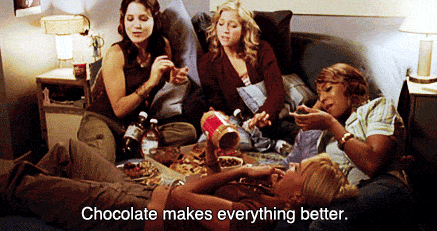
We're thankful that this one's a myth. Some teenagers actually steer clear of chocolate because they think it single-handedly causes acne.
You will be relieved to know that studies have shown that there is no connection between chocolate and skin problems, and that some types of chocolate may even be good for you (aw yeah). Now you can enjoy each bite of your lip-smacking chocolate bar without any worries.
2. Eggs are the main cause of high cholesterol.

Eggs are a nutritional powerhouse, but for a while the egg yolk has been demonized as a cause of high cholesterol. Is it true? Well, the answer is NO.
The real threat behind high cholesterol is saturated and trans fat, not dietary cholesterol present in yolk. So banish the old notion that an egg, specifically the yolk, is hazardous to your health, and make yourself an omelette.
3. Calories eaten at night are more fattening than those eaten early in the day.

The common knowledge today is that a calorie is a calorie. So regardless of when you eat it, what causes weight gain is simply eating more calories than you burn. No matter when you eat, the effect will always be the same.
4. You should drink eight glasses of water a day.
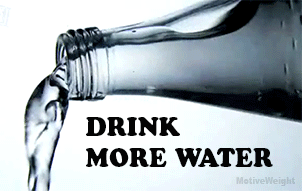
We do need a lot of water for our daily functioning, but 8 glasses is just a too-popular-to-be-ignored figure. In reality, there is no hard rule that says you should consume eight glasses of water daily.
Our liquid intake doesn't just depend on water, it also includes other beverages as well. So stop gulping down eight whole glasses of water just to get the number right, and drink a beer instead. #college
Original post by Veenisha Tutlani for Spoon University - Delhi.
For more, like Spoon University on Facebook or pin them on Pinterest.
-- This feed and its contents are the property of The Huffington Post, and use is subject to our terms. It may be used for personal consumption, but may not be distributed on a website.
Often Ignored: Healthcare Employees' Well-Being
Drug for early breast cancer licensed
Monday, September 28, 2015
6 Great Excuses To Drink Coffee Every Day Of Your Life
Coffee means a great deal to a great many people, but its primary purpose in our lives is to perk us up and make us presentable to the world. Right? Isn't that why so many of us buy mugs that say "Don't talk to me until I've had my coffee?"
Well, there are some wonderfully positive long-term effects that coffee can have on your body too, and it's time to consider them. Did you know drinking coffee can help your stress levels, boost your liver health, and possibly even make you smarter? In honor of National Coffee Day on Sept. 29, check out the video above to see the six ways java can make you a better person.
For more information on the reasons in the video above, read all about the reasons you should drink coffee every day.
Related on HuffPost:
-- This feed and its contents are the property of The Huffington Post, and use is subject to our terms. It may be used for personal consumption, but may not be distributed on a website.
6 Great Excuses To Drink Coffee Every Day Of Your Life
Coffee means a great deal to a great many people, but its primary purpose in our lives is to perk us up and make us presentable to the world. Right? Isn't that why so many of us buy mugs that say "Don't talk to me until I've had my coffee?"
Well, there are some wonderfully positive long-term effects that coffee can have on your body too, and it's time to consider them. Did you know drinking coffee can help your stress levels, boost your liver health, and possibly even make you smarter? In honor of National Coffee Day on Sept. 29, check out the video above to see the six ways java can make you a better person.
For more information on the reasons in the video above, read all about the reasons you should drink coffee every day.
Related on HuffPost:
-- This feed and its contents are the property of The Huffington Post, and use is subject to our terms. It may be used for personal consumption, but may not be distributed on a website.
Atezolizumab set to change refractory lung cancer treatment
What is Love?

In this video, Eckhart Tolle explains the deeper meaning of Love. In romantic relationships it is vital to recognize your partner is much more than who or what he or she appears to be on the surface. If you get stuck in the personality of your partner, you will be stuck on the superficial level. There is a depth in your partner, and yourself beyond superficial appearances.
-- This feed and its contents are the property of The Huffington Post, and use is subject to our terms. It may be used for personal consumption, but may not be distributed on a website.
Opdivo (nivolumab) Demonstrates Long Term Survival Benefit in Patients with Previously Treated Non-Squamous Non-Small Cell Lung Cancer in CheckMate -057
10 Fun Foods for Football Season
1. Grilled Buffalo Wings with Seasoned Buffalo Sauce
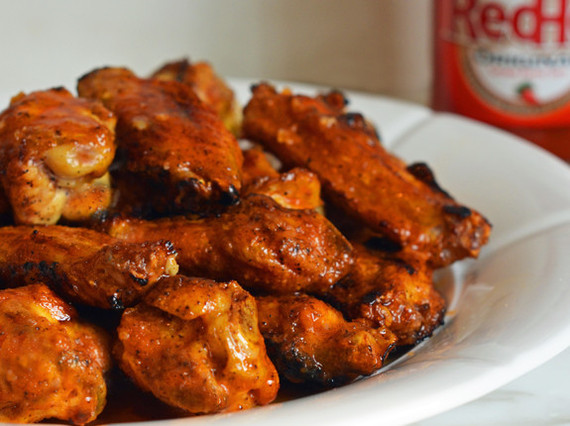
Classic Buffalo wings are fried but I love the flavor and ease of cooking them on the grill -- they are truly no fuss, no muss and finger lickin' good! The seasoned Buffalo sauce takes them over the top; it's made with garlic and spices, which makes it more flavorful than your typical hot sauce. GET THE RECIPE
2. Roasted Garlic Guacamole
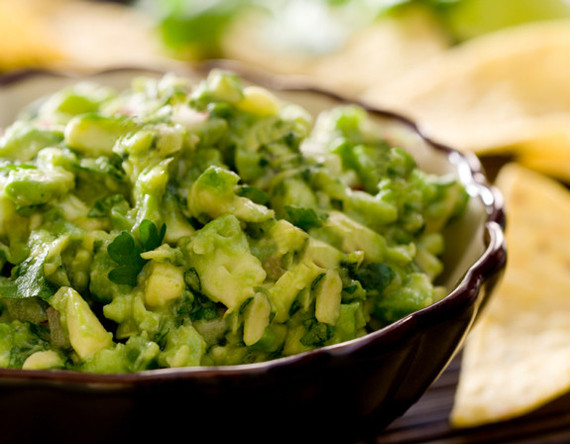
While traditional guacamole is made with raw onions, this updated version is made with roasted garlic, which has just as much flavor and none of unpleasant aftertaste. Always a crowd-pleaser! GET THE RECIPE
3. White Chicken Chili

Made with a store-bought rotisserie chicken, this is an easy chicken chili that you can prepare for your crowd in under an hour. GET THE RECIPE
4. Peel N' Eat Shrimp
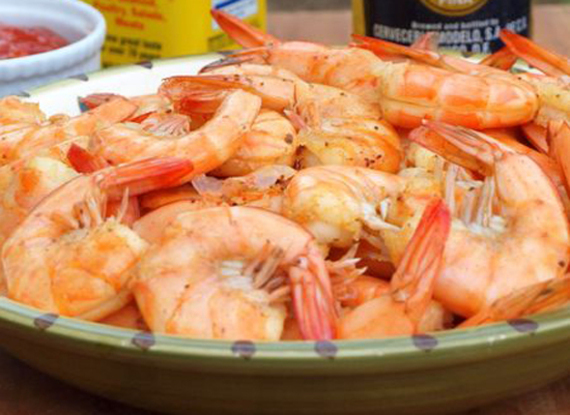
Peel n' Eat Shrimp are as easy to make as they are fun to eat. Here, they're prepared Maryland-style: simmered in beer and Old Bay with homemade cocktail sauce on the side. GET THE RECIPE
5. Rosemary Nuts
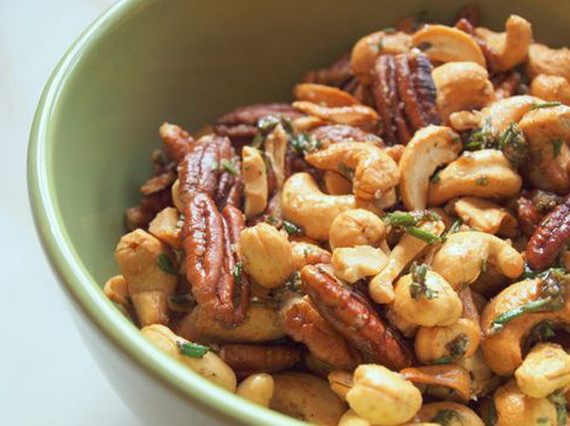
Inspired by the famous bar nuts served at Union Square Cafe in New York, these sweet, spicy and salty rosemary nuts are wildly addictive. GET THE RECIPE
6. Chocolate Chip Pecan Blondies
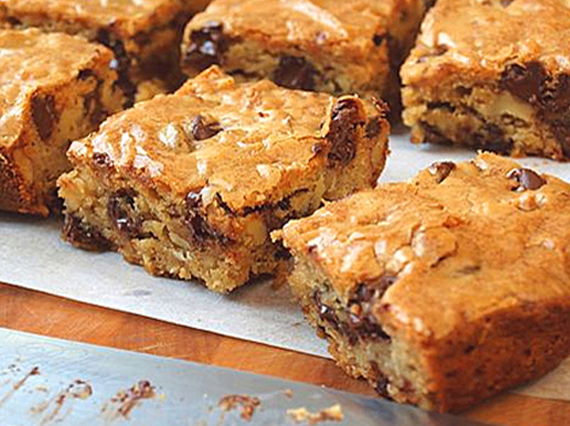
You gotta have something sweet when watching football, and these easy-to-make chocolate chip blondies are always a crowd-pleaser. GET THE RECIPE
7. Crazy Good Spicy Italian Popcorn
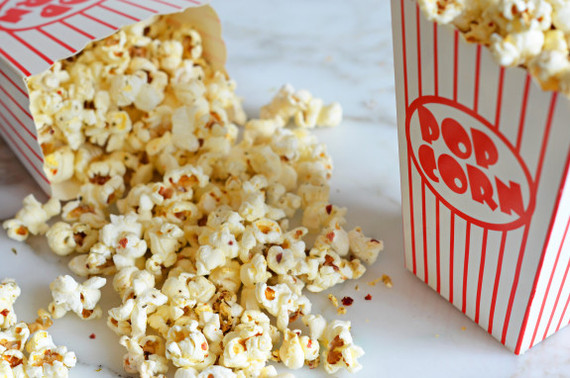
This fun snack -- homemade popcorn tossed with garlic butter, Parmesan, oregano and red pepper flakes -- is adapted from Crazy Good Italian by D.C. Chef and Top Chef All-Stars runner-up Mike Isabella. It's insanely addictive (yes, crazy good) and exemplifies Isabella's self-described cooking style: one part old-world Italian, one part old-school Jersey, one part modern Mediterranean -- all parts delicious. GET THE RECIPE
8. Crispy Kale Chips with Lemon & Parmesan
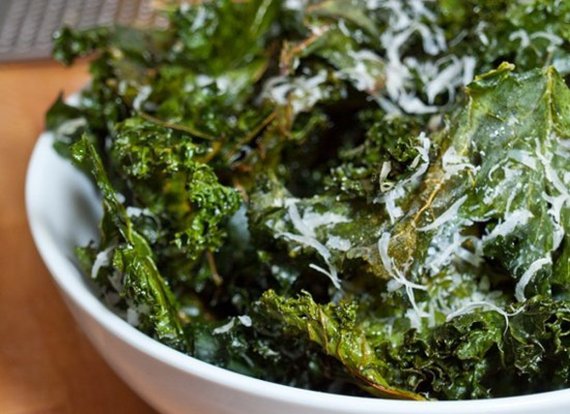
Who says football snacks have to be unhealthy? These crispy chips are made from one of the healthiest vegetables on the planet. GET THE RECIPE
9. Chile con Queso
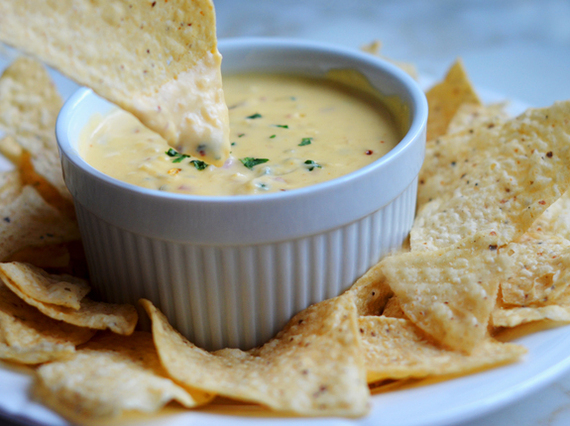
This homemade queso is rich, creamy, a little spicy -- and dangerously addictive when served hot with tortilla chips. GET THE RECIPE
10. Chocolate Peanut Butter Squares

Who can resist chocolate and peanut butter? A crumbly chocolate wafer crust, rich and creamy peanut butter layer, and smooth-as-silk milk chocolate topping make these squares absolutely irresistible. GET THE RECIPE
-- This feed and its contents are the property of The Huffington Post, and use is subject to our terms. It may be used for personal consumption, but may not be distributed on a website.
Sharp Healthcare dedicates brain cancer program
Opdivo (nivolumab) Demonstrates Long Term Survival Benefit in Patients with Previously Treated Non-Squamous Non-Small Cell Lung Cancer in CheckMate -057
3 Smart Ways to Reduce Your Healthcare Costs
October is Breast Cancer Month: Events and Activities
Sunday, September 27, 2015
Drug combination improves progression-free survival in melanoma patients
OncoGenex Pharmaceuticals : Presents Additional Phase 3 SYNERGY Analyses Showing Custirsen Significantly Reduced Serum Clusterin Levels in Metastatic Prostate Cancer Patients; Low Levels Correlate with Improved Survival in Those at Increased Risk for…
TAILORx trial finds 99 percent of women with low Oncotype DX® Recurrence Score® are free of breast cancer recurrence after five years of hormone therapy alone
This Is How Laughter Really Affects Your Body
In the spirit of celebrating moments that make you laugh like you mean it, we’ve teamed up with Always® Discreet to look at all the ways your giggles, snorts and roars of laughter affect your body. Spoiler alert: It’s good for you, from your head to your toes. So laugh it up!

Image: HuffPost Partner Studio
Always® Discreet believes that you should never miss a chance to laugh, and you should never let a sensitive bladder stop you from enjoying life’s side-splitting moments. That’s why they’ve created Always® Discreet for Sensitive Bladders - a collection of liners, pads and underwear so you’ll never be held back by leaks. So go ahead, laugh like you mean it! See more from Always® Discreet at Purple Clover.
-- This feed and its contents are the property of The Huffington Post, and use is subject to our terms. It may be used for personal consumption, but may not be distributed on a website.
On 60 Minutes, Donald Trump Accidentally Proposes Radical Reform Of U.S. Healthcare
Saturday, September 26, 2015
Circulating Tumor Cells (CTCs) Prognostic Technologies Market to Reach US$0.43 Bn by 2020 due to Rising Prevalence of Cancer: Transparency Market Research
Circulating Tumor Cells (CTCs) Prognostic Technologies Market to Reach US$0.43 Bn by 2020 due to Rising Prevalence of …
14:07 GMT
Alnaby – New York, Sept. 25, 2015 (GLOBE NEWSWIRE) — A research study on the global circulating tumor cells (CTCs) prognostic technologies market has been published by Transparency Market Research (TMR), a market intelligence and research firm. The report pegs the overall value of this global market in 2013 at US$0.43 bn.The research report, titled “Circulating Tumor Cells ( … (continue reading)
New diversity for lager beers
Tone At Home With This 10-Minute Workout
By Amy Schlinger, SELF
You already know that push-ups, squats and lunges are body-sculpting all-stars. But you can get more out of them to spike your heart rate, boost caloric burn and elevate your metabolism--without a single piece of equipment explains Erin Bulvanoski, trainer at KORE in New York City. This expert-designed sequence combined with cardio challenges turns the basic moves into a a formula for total-body toning.
Since this routine doesn't require anything other than your own body it can be done in your living room or bedroom first thing when you wake up in the morning. Start with a quick warm up (two-three minutes of jumping jacks and jogging in place) then tackle the moves below.
1. Standing Lunges
Start standing with feet together. Step right leg forward, bend knees, keeping right knee stacked over right ankle, left hip in line with left knee. Straighten legs and return to standing; alternate sides with each rep. Do this for 60 seconds.
Rest 15 seconds.
2. Push-Ups
Start in a high plank with wrists directly under shoulders, body in straight line from head to toe. Bend elbows, keeping them close to torso, to lower chest to ground, then straighten arms. Do this for 60 seconds.
Rest 15 seconds.
3. Jumping jacks
Stand tall with arms by sides. Jump legs apart and swing hands overhead. Jump feet back together as hands come back down to sides. Do this for 90 seconds.
Rest 30 seconds.
4. Plank Taps
Start in a high plank with wrists directly under shoulders, body in straight line from head to toe. Shift weight to left side and lift right arm, bringing right hand to tap left shoulder. Return right hand to the ground; alternative sides with each rep. Do this for 60 seconds.
Rest 15 seconds.
5. Bicycle Crunches
Lie face up with hands touching behind head, elbows out wide and legs extended. Lift torso, arms and legs off ground. Bend left knee and twist body to the left, bringing right elbow to meet left knee over the torso; alternate sides with each rep. Do this for 60 seconds.
Rest 15 seconds.
6. Jump Squats
Start standing with feet hip-width apart and arms by sides. Squat down, keeping chest lifted, then explode up. Land and immediately lower into the next rep. Do this for 90 seconds.
Rest 30 seconds.
7. Twisting Mountain Climbers
Start in a high plank with wrists directly under shoulders, body in straight line from head to toe. Bring right knee under torso to meet left elbow, then bring left knee to meet right elbow. Continue to alternate sides quickly. Do this for 60 seconds.
More from SELF:
Your Do-Anywhere, Total-Body Workout
The Genius Trick for Perfect Scrambled Eggs
What's Your Sex Number?
The One Thing Hairstylists Wish You'd Stop Doing
5 Relationship Red Flags That Don't Have to Be Dealbreakers
The One Thing Dermatologists Wish You'd Stop Doing
4 Things Men Hide From Their Wives
Also on HuffPost:
-- This feed and its contents are the property of The Huffington Post, and use is subject to our terms. It may be used for personal consumption, but may not be distributed on a website.
Coffee Makers That Won't Take Up Your Valuable Counter Space
While you may be willing to devote most of your morning to consuming many cups of coffee, you probably don't want to devote all your precious counter space to your coffee maker.
The space atop kitchen cabinets is prime real estate and needs to be used wisely. If your kitchen isn't palatial, you can appreciate a collapsable dish drain or maximized pantry organization. You understand that admiring those adorable sugar and flour canisters on store shelves is your only realistic option and you seriously appreciate a small (yet functional!) appliance.
If you live in a small space or you just prefer a clean kitchen counter, and would call yourself a coffee drinker, you know the space dilemma all too well. If you want a decent coffee maker that can brew a full pot (we're talking 12 cups, friends) and not take up a tremendous amount of space, we've got a few options for you.
Keep an open mind, some new techniques for brewing could be just the answer you're looking for. You may not have to give up all your counter space after all.
-- This feed and its contents are the property of The Huffington Post, and use is subject to our terms. It may be used for personal consumption, but may not be distributed on a website.
Asbestos, disease burden, and TSCA reform
COPD heightens deadly lung cancer risk in smokers
Blooming Prairie boy, family journey through brain cancer diagnosis
UK cancer survival worst in western Europe
Healthcare In 10 Years: Telemedicine Will Just Be Medicine
Friday, September 25, 2015
Tell us: Have you faced a decision on breast cancer treatment?
Eleven-year cosmic search leads to black hole rethink
Reduced prostate screening could miss advanced tumors
Reduced prostate screening could miss advanced tumors
Reduced prostate screening process can miss innovative tumors
12:47 GMT
Unwinded guidelines on prostate cancer cells screening process may postpone medical diagnosis and also treatment of aggressive growths, an aspiring study recommends. In 2011, the UNITED STATE Preventive Solutions Activity Force advised versus routine prostate certain antigen (PSA) screening, to suppress over-diagnosis and also overtreatment of prostate cancer cells. Ever since, PSA testing has lost by 28 percent, the researchers report. … (proceed reading)
6 Reasons Why My Introversion Makes Me A Better Mom
I wasn’t always cool with being an introverted parent. I wanted to be one of those moms who thrived among children—the mom who’s always on, always available emotionally; the mom who invites all the neighborhood kids over for snacks every day. But that’s just not me. I love my kids, but there’s a reason I’m always suggesting we play hide-and-seek. (There’s something about a dark closet...)
I viewed my introversion as a parental liability, a flaw I had to overcome. Lately, though, I’ve been wondering: could my introverted personality be a benefit? Does it actually, in some ways, make me a better parent?
The answer, I think, is yes. When I look at my skillset as a parent and the areas where I feel confident, I can see where my introversion is an asset. This isn’t to say that introverted parents are automatically the best kind of parents—or vice versa. Not at all. But for my sake, it definitely helps to celebrate some of the ways introversion makes me a better mom. For example:
I stay in tune with my kids. I tend to analyze everything—someone’s comment on Twitter, a weird facial expression from my husband, a friend’s text. I put as much thought into what others are saying as I do into what I’m saying. This can be exhausting for me (and overwhelming to my friends and family), but when it comes to my kids, this kind of overthinking actually helps me stay in tune with them. I’m good at reading their emotions and faces, in addition to their words. I can get to the bottom of feelings, when otherwise I might have accepted a brush-off statement like ”I’m fine, Mom.”
I am helping my kids process their own feelings. I’m a processing savant. Put me in a situation, and I’ll look at it from multiple angles, think it through to its conclusion, and come to a reasonable plan of action. You know who doesn’t do that very well? A 6-year-old. If one of my kids is dealing with a tricky situation at school, no one’s better at helping them work through it than I am.
Maintaining one-on-one connections with multiple kids. I may not throw myself into the lions’ den when all four kids are playing together, but I am definitely comfortable showering each one individually with attention. One of my favorite routines is something we call a “slumber party” at our house. It’s not an actual slumber party but an intentional time when I lie in bed with one of my kids at the day’s end. We spend the time just talking. Something about the intimate bedtime setting helps us connect. I feel like these bedtime moments help me get to know my kids’ hearts in a deeper way.
Having empathy for my children. This is especially true with my more introverted kids. My oldest daughter, for example, is a classic introvert. A couple of weeks ago, she had a playdate with four friends that lasted longer than we had planned. Around hour two of the eventually three-hour playdate, I found her in her room reading alone, with the door closed. Her friends were playing in the living room with my other kids. Everyone was having fun, so instead of forcing her into social interaction, I just let her be. This situation might drive an extrovert crazy, but I totally understand the impulse to get away.
Lowered emotional reactivity. Introverts are internal processors. For me, that means that my emotions are usually pretty well hidden under the surface. This can pose problems, but I’ve found this to be a huge benefit when it comes to discipline and children. When a kid misbehaves, I may get all rage-y inside, but outwardly I’m far less emotional, less reactive, and more logical. Whether it’s dealing with gum in the hair or discovering my youngest wrote her name in Sharpie on the kitchen table, I can usually keep my cool.
Modeling how to enjoy being alone. We talk a lot in our house about alone time. I love to read. I love music. I want my kids to love those things too, and they do. As an introvert, I’m able to model for them the value of alone time. My kids see me reading books, practicing the piano, or otherwise entertaining myself without the need of external stimulation, TV, or a sibling. Being alone and not bored is a very valuable thing for kids to learn.
Those are some of the ways I’ve begun making positive connections between my personality and my parenting style. What about you? What other ways could being an introvert benefit us as parents?

This article originally appeared on QuietRev.com.
You can find more insights from Quiet Revolution on work, life, and parenting as an introvert at QuietRev.com.
Follow Quiet Revolution on Facebook and Twitter.
Also on HuffPost:
-- This feed and its contents are the property of The Huffington Post, and use is subject to our terms. It may be used for personal consumption, but may not be distributed on a website.